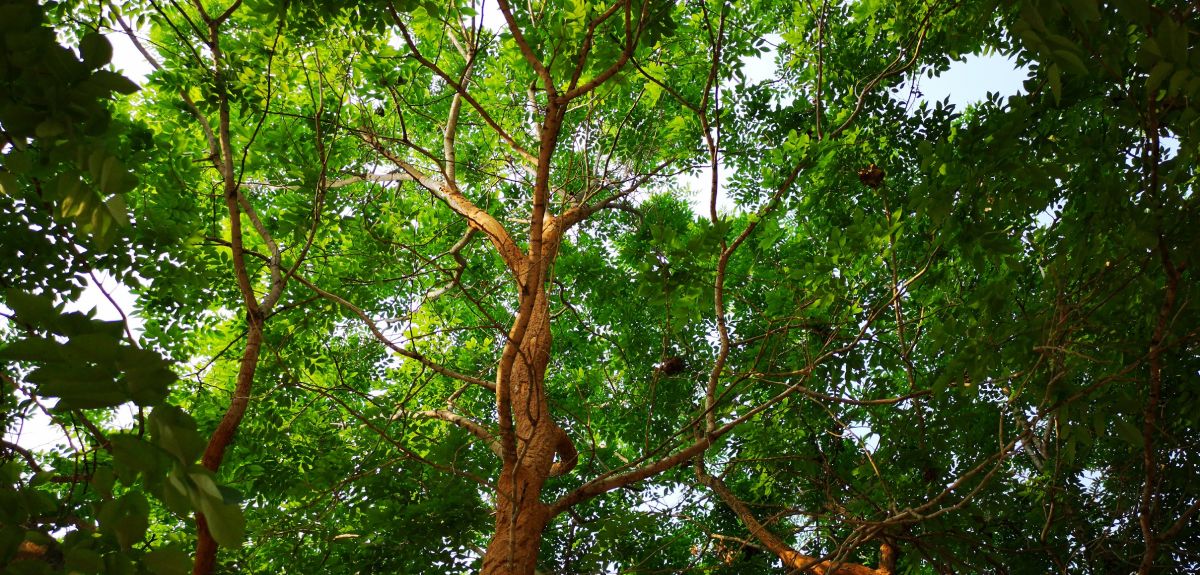
The race to save the world’s most trafficked wild species
When it comes to saving the world’s most trafficked wild species – Dalbergia, the rosewood tree- two things are absolutely essential.
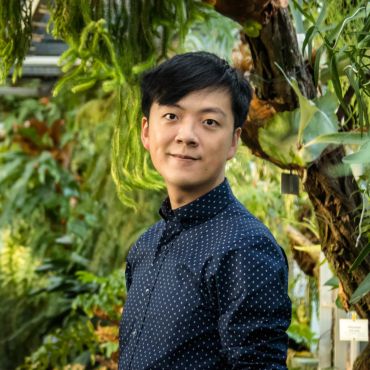 Dr Tin Hang (Henry) Hung. Credit: Henry Hung.
Dr Tin Hang (Henry) Hung. Credit: Henry Hung.You also need vision, because there are no simple ‘quick fix’ solutions. As Dr Tin Hang (Henry) Hung from the University of Oxford’s Department of Biology, says: ‘The rosewood trade is deeply complex, involving many different actors across multiple countries, including indigenous people who depend on selling forestry products to survive. Any attempt to restore rosewood populations therefore needs to be a collaborative approach that addresses the underlying issues fuelling this trade, particularly extreme poverty.’
Fortunately, the rosewood tree has a team of highly ambitious and driven champions. Over the past six years, University of Oxford researchers have supported a project that has brought together plant geneticists, forestry workers, conservationists, local communities, and indigenous people in the race to save the rosewood. By combining local knowledge, forestry management techniques, and cutting-edge plant genetics, these efforts have reduced the pressures on wild rosewood populations, whilst developing pioneering new tools to support conservationists. In combination, this work has provided, as Henry says; ‘a blueprint for how conservation should be done – using approaches that restore wild species while empowering local people through sustainable livelihoods.’
‘Nature has no borders’
This project has really demonstrated the power of the collaborative approach and the benefits of conservationists working with University of Oxford researchers. This will support the Department of Forestry to improve rosewood tree plantation, and also the Department of National Parks, Wildlife and Plant Conservation to make decisions on the best practices for rosewood conservation.
Dr Voradol Chamchumroon Head of Department at the Forest Herbarium, Department of National Park, Wildlife and Plant Conservation, Thailand
Henry’s fascination with rosewoods began as a DPhil student researching genetic diversity of Dalbergia populations. ‘I have always been fascinated about the connections between trees and people’ he says. ‘Trees are fundamental to our survival and restoring forests will be crucial for both mitigating climate change and conserving biodiversity. But many species have been overexploited to the point that they are now endangered. For instance, my home city Hong Kong is thought to be named after the fragrance tree Aquilaria sinensis, which was historically ubiquitous but now at risk of extinction.’
During his studies, Henry became deeply concerned about the speed at which rosewood forests were disappearing. In 2018, this motivated him to join a new rosewood conservation consortium set up by his DPhil supervisors Professor John MacKay and Dr David Boshier in partnership with the Alliance of Bioversity International and CIAT, the University of Copenhagen, and national research institutions from five countries in the Greater Mekong sub-region.* This had been launched with funding from The Darwin Initiative: a UK government grants scheme which aims to help protect biodiversity and the natural environment.
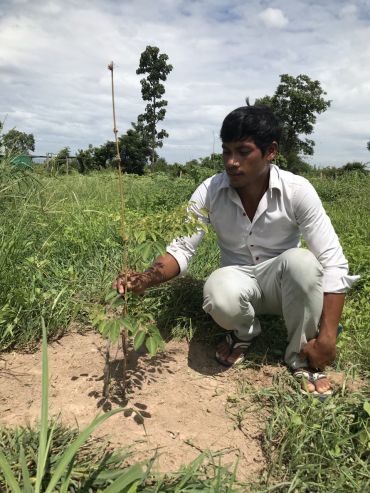 Cambodian farmer Mr Sok Em with rosewood seedlings established on his farmland. Credit: IRD, Cambodia.
Cambodian farmer Mr Sok Em with rosewood seedlings established on his farmland. Credit: IRD, Cambodia.Such an ambitious project would require all stakeholders to be engaged, if it was to have any chance of success. The project team set about creating a network of contacts within forestry offices, national park authorities, conservation organisations, local communities, and indigenous peoples in four countries across the rosewood’s native range: Cambodia, Laos, Thailand, and Vietnam. These were all brought together for stakeholder workshops (in-person to start with, but successfully transitioned online when the COVID-19 pandemic struck).
‘Rosewood species are severely threatened across all countries in their distribution range, so collaboration between countries is paramount to conserve their remaining diversity’ says Dr Riina Jalonen from the Alliance of Bioversity International and CIAT. ‘By bringing together all stakeholders, this enabled networking and the exchange of valuable information and experiences in rosewood conservation and management.’
‘When you have such a large number of different stakeholders, often with different interests, it can be difficult to coordinate effective actions’ adds Henry. ‘In these situations, academic institutions such as the University of Oxford can play an important role by acting as a “glue” to bring people together, build trust, and facilitate knowledge exchange.’
Solving two problems with one action
The pressure on these rosewood species is immense, from illegal logging, habitat destruction and climate change, and it is no longer likely their populations can recover in their natural habitats without interventions. This study is an important step towards recovery of two of the world's most trafficked species and provides a model for the conservation of other endangered tropical tree species too.
Dr Ida Hartvig, Biologist, University of Copenhagen
Through engaging this wide network, it became clear that there was an opportunity to address local needs alongside conservation goals. In many of the regions where rosewood is naturally found, particularly mountainous areas unsuitable for agriculture, poverty levels can be high. However, the team knew from a previous small-scale project that local people could be supported to collect rosewood seeds and grow seedlings as a source of secondary income. This created a way to achieve two goals at once: generating local sources of rosewood seedlings for conservation, whilst providing sustainable livelihoods.
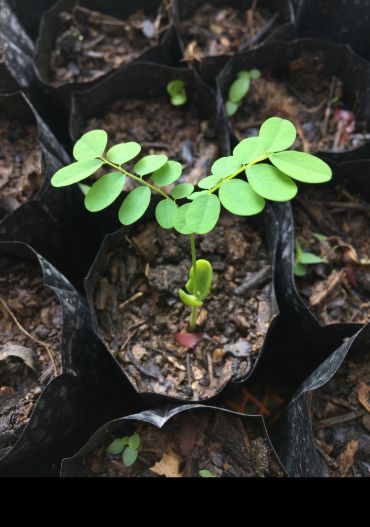 A Dalbergia oliveri seedling. Credit: Shutterstock.
A Dalbergia oliveri seedling. Credit: Shutterstock.Because financial empowerment is inextricably linked with gender equity, a key goal for the project was to improve gender representation within the forestry trade. ‘Traditionally, the forestry trade is very male-dominated as this can involve travelling to remote locations, climbing trees, and being exposed to dangerous animals’ says Henry. ‘Rosewood farms offer women a more accessible means to benefit from this industry.’ Consequently, the project team ensured that at least a third of the indigenous people trained in each country were women.
Within just three years, and despite the challenges created by the COVID-19 pandemic, this approach had already had a significant impact on boosting local incomes. In Cambodia, for instance, communities supported by the project saw average income from selling rosewood seedlings almost double from $300 to $569 a year. For one of the largest nurseries, in the Pursat region of Cambodia, improved methods led to an almost doubled production, from 40,000 to 90,000 rosewood seedlings annually. Besides reducing the pressure on wild rosewood populations, these nurseries also provide a local source of seedlings for reforesting projects.
You can learn more about the threats facing rosewoods and the project to save them in this video produced by Alliance of Bioversity International and CIAT.
Breaking a genetic bottleneck
The project is a rare example of the value of close collaboration between government staff, practitioners and conservationists working on the ground and geneticists. Engagement of local staff and field researchers enabled collection of DNA samples from remnant populations, the University of Oxford researchers performed the genetic analyses and made the results available including as a web-based tool useful in the next generation of hands-on conservation efforts for these precious species.
Dr Ida Theilade, Plant Geneticist, University of Copenhagen
Simply planting more trees, however, won’t be enough to secure the rosewood’s future. With wild populations having been so decimated, low genetic diversity can be a major concern as this reduces seed production, seedling survival, and growth. Furthermore, the effects of climate change mean that trees planted today may not be suited to conditions in the near future. This meant that a key priority for the project was to map the remaining genetic diversity to identify “genetic hotspots” to prioritise for conservation.
Through the network of partners, the project sourced over 800 samples of rosewood leaves from across Southeast Asia which were then sent to Henry in Oxford for DNA sequencing. These included new collections gathered by the partners over the past few years, and also archival collections from Dr Ida Hartvig at the University of Copenhagen from the last decade. ‘It was very sobering to realise that for some of the samples, the original populations in the field had already disappeared, and I was now handling the last remnants of their genetic material’ says Henry.
The first step involved producing the first-ever reference genome for Dalbergia cochinchinensis and Dalbergia oliveri. These were used as baselines for measuring genetic variation among the samples. The genetic data was then combined with geographic information to generate comprehensive distribution maps of rosewood genomic diversity. ‘Notably, this revealed that coastal regions have especially high levels of local adaptation, making them a conservation priority’ says Henry. ‘This may possibly be due to their exposure to more variable environmental conditions on the coast, and their distance from core inland populations may also have allowed them to evolve new genetic diversity at the frontier of the species’ range.’ Using these insights, the project team established 23 new conservation units, creating new jobs for local people as forestry and conservation officers.
Today’s seeds for tomorrow’s forests
If we want the impacts of this work to be self-sustaining, we have to empower conservationists, policy makers and local people to use genetic data as a tool to aid conservation decisions. So right from the start, we were committed to developing user-friendly and open-access online tools to support decision making.
Dr Tin Hang (Henry) Hung, Lead Author & Project Co-Lead, University of Oxford
Building on this, Henry applied this “treasure trove” of genetic data to investigate which genes were intricately linked with environmental adaptation. This identified genetic variants that were strongly associated with environmental variables, such as average rainfall levels and temperature variation. These findings enabled the team to project the "genetic offset" for different rosewood populations, to understand the mismatch between present genetic adaptability and anticipated climate scenarios up to 2100 (recently published in the journal PNAS).
‘Because the effects of climate change are happening so quickly, local rosewood populations will not have time to evolve and adapt by natural selection’ explains Henry. ‘This means that assisted migration will become an increasing focus within conservation, where populations are intentionally established beyond their historic range to track areas with suitable habitat through a period of change.’
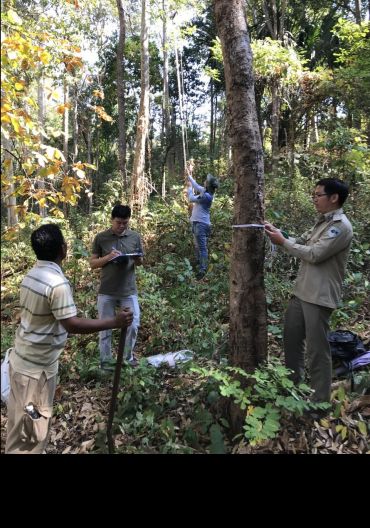 Workers from the Institute of Forestry and Wildlife Research and Development in Cambodia map and measure Dalbergia oliveri seed-producing trees. Credit: IRD, Cambodia.
Workers from the Institute of Forestry and Wildlife Research and Development in Cambodia map and measure Dalbergia oliveri seed-producing trees. Credit: IRD, Cambodia.Alongside this, the genetic database was developed into a bespoke online application called seedeR: a seed-selection tool for rosewood farmers, conservationists, and forestry workers. ‘It is a very user-friendly tool. You simply input the latitude and longitude of a location and it will calculate the most suitable seed source based on the predicted conditions in fifty years’ time’ says Henry.
‘All too often, genomic technologies are inaccessible to conservationists due to a lack of genomics expertise, state-of-the-art technologies, and resources’ he adds. ‘But we have demonstrated that through connecting people and focusing on the needs of end-users, genomic technologies can directly support rapid decision-making and conservation activities.’
With the seedeR interface requiring no specialist knowledge, conservationists are not the only ones who will benefit, as plant geneticist Dr Ida Theilade (University of Copenhagen) explains: ‘To many low-income households, farming rosewood trees acts as a security in times of financial crises and shocks, including for female headed households. As a publicly accessible tool, seedeR will help farmers select seed sources matching planting sites and thereby secure better income from family-based tree-planting activities.’
Hope for the future
This project has highlighted natural adaptations in rosewood trees, and specifically matched genetic diversity to environmental conditions. Genomics research has improved our understanding and given us a toolkit to effectively conserve adaptation potential in remaining trees under a changing climate.
Professor John MacKay, Senior Author & Project Co-Lead, University of Oxford
With new funding from a National Geographic Society grant, Henry intends to confirm the gene-environment associations by growing seedlings under controlled conditions, and identifying which genes are expressed differently in response to environmental stresses. ‘Ultimately, we hope to develop genetic markers so that varieties with key desirable traits, such as drought tolerance, can be identified with a simple genetic screen rather than having to grow them in the field, which takes many years. This would massively accelerate conservation efforts, by reducing the time needed to identify optimum varieties’ he says.
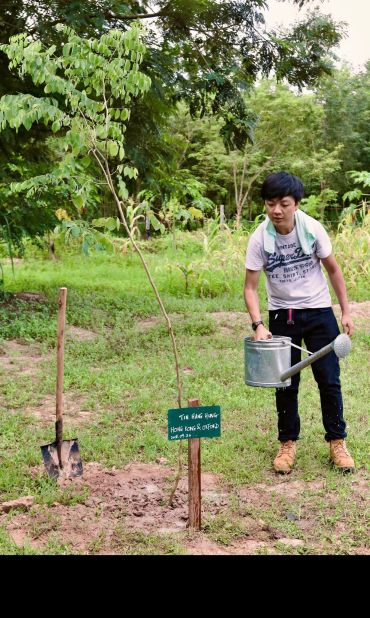 Henry planting a Siamese rosewood tree (Dalbergia cochinchinensis) in Cambodia, September 2018, to commemorate the launch of the project. Credit: Henry Hung and David Boshier.
Henry planting a Siamese rosewood tree (Dalbergia cochinchinensis) in Cambodia, September 2018, to commemorate the launch of the project. Credit: Henry Hung and David Boshier.‘I, for one, am really grateful to my DPhil supervisors John and David, all my collaborators, and all the people living on the land of Mekong who have inspired my research today’ he adds. ‘Forests in southeast Asia nurtured me to become a forest scientist, and I still want to be one for many decades to come. Hopefully some day in my career, I will see rosewoods delisted from the IUCN Red List.’
The study ‘Range-wide differential adaptation and genomic offset in critically endangered Asian rosewoods’ has been published in the journal PNAS.
*The project ‘Conserving Rosewood genetic diversity for resilient lives in the Mekong’ was led by the University of Oxford in partnership with the following organisations: the Alliance of Bioversity International and CIAT; the University of Copenhagen; the Institute of Forest and Wildlife Research and Development of Cambodia; the National Agriculture and Forestry Research Institute of Lao PDR; the Vietnamese Academy of Agricultural Sciences; the Department of National Parks Wildlife and Plant Conservation of Thailand; the Chinese Academy of Forestry.
 What US intervention could mean for displaced Venezuelans
What US intervention could mean for displaced Venezuelans  10 years on: The Oxford learning centre making an impact
10 years on: The Oxford learning centre making an impact Oxford and The Brilliant Club: inspiring the next generation of scholars
Oxford and The Brilliant Club: inspiring the next generation of scholars New course launched for the next generation of creative translators
New course launched for the next generation of creative translators The art of translation – raising the profile of languages in schools
The art of translation – raising the profile of languages in schools  Tracking resistance: Mapping the spread of drug-resistant malaria
Tracking resistance: Mapping the spread of drug-resistant malaria